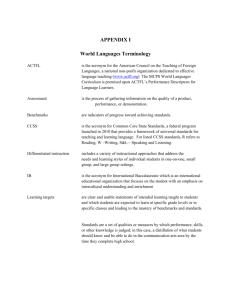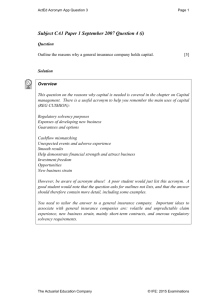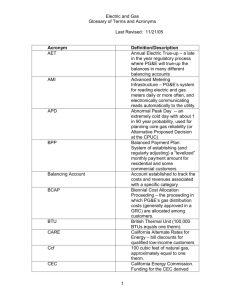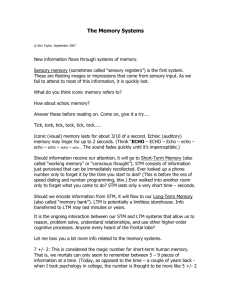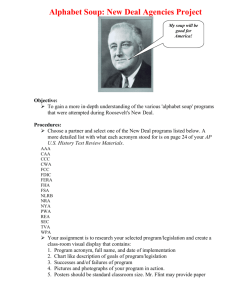Using compression to identify acronyms in text
advertisement
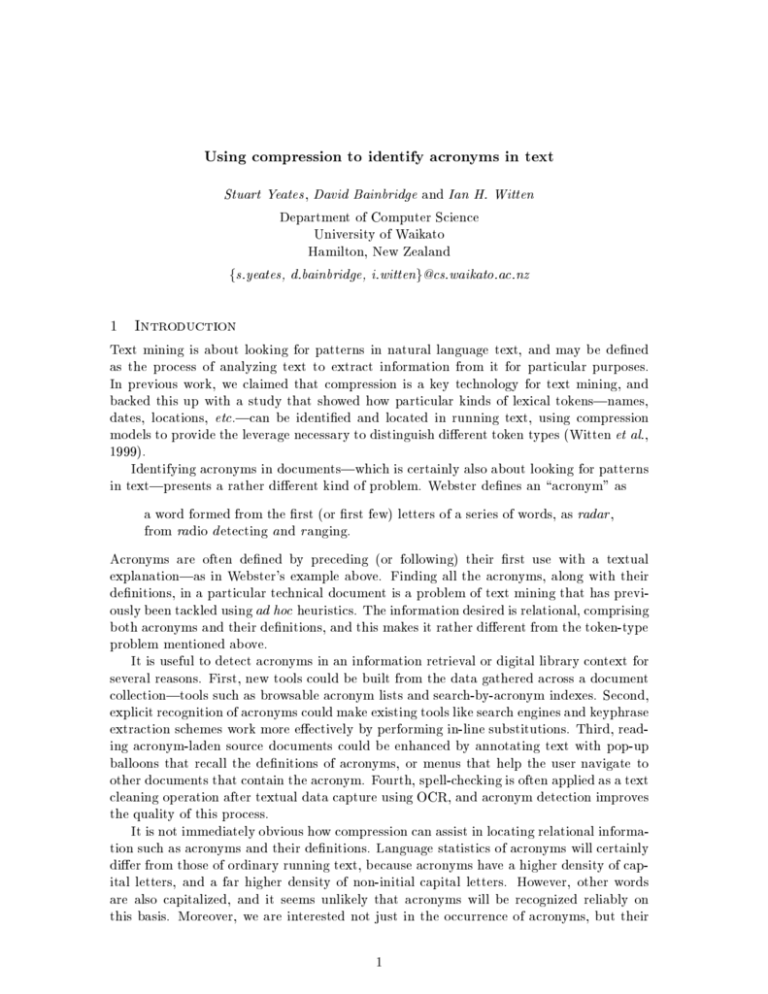
Using compression to identify acronyms in text
Stuart Yeates , David Bainbridge and Ian H. Witten
Department of Computer Science
University of Waikato
Hamilton, New Zealand
fs.yeates, d.bainbridge, i.witteng@cs.waikato.ac.nz
1
Introduction
Text mining is about looking for patterns in natural language text, and may be dened
as the process of analyzing text to extract information from it for particular purposes.
In previous work, we claimed that compression is a key technology for text mining, and
backed this up with a study that showed how particular kinds of lexical tokens|names,
dates, locations, etc.|can be identied and located in running text, using compression
models to provide the leverage necessary to distinguish dierent token types (Witten et al.,
1999).
Identifying acronyms in documents|which is certainly also about looking for patterns
in text|presents a rather dierent kind of problem. Webster denes an \acronym" as
a word formed from the rst (or rst few) letters of a series of words, as radar ,
from ra dio d etecting a nd r anging.
Acronyms are often dened by preceding (or following) their rst use with a textual
explanation|as in Webster's example above. Finding all the acronyms, along with their
denitions, in a particular technical document is a problem of text mining that has previously been tackled using ad hoc heuristics. The information desired is relational, comprising
both acronyms and their denitions, and this makes it rather dierent from the token-type
problem mentioned above.
It is useful to detect acronyms in an information retrieval or digital library context for
several reasons. First, new tools could be built from the data gathered across a document
collection|tools such as browsable acronym lists and search-by-acronym indexes. Second,
explicit recognition of acronyms could make existing tools like search engines and keyphrase
extraction schemes work more eectively by performing in-line substitutions. Third, reading acronym-laden source documents could be enhanced by annotating text with pop-up
balloons that recall the denitions of acronyms, or menus that help the user navigate to
other documents that contain the acronym. Fourth, spell-checking is often applied as a text
cleaning operation after textual data capture using OCR, and acronym detection improves
the quality of this process.
It is not immediately obvious how compression can assist in locating relational information such as acronyms and their denitions. Language statistics of acronyms will certainly
dier from those of ordinary running text, because acronyms have a higher density of capital letters, and a far higher density of non-initial capital letters. However, other words
are also capitalized, and it seems unlikely that acronyms will be recognized reliably on
this basis. Moreover, we are interested not just in the occurrence of acronyms, but their
1
denitions too, and these will certainly not be readily distinguished from ordinary language
by their letter statistics.
We have experimented with a simple way of coding potential acronyms with respect to
the initial letters of neighboring words, and using the compression achieved to signal the
occurrence of an acronym and its denition. This seems to form the basis for a reliable
acronym nder. The next section discusses acronyms themselves, and distinguishes them
from ordinary abbreviations. Following that we examine three existing systems for acronym
extraction from text. These rely heavily on heuristics that are provided a priori by the
system designer, based on the designer's experience and skill. In Section 4 we introduce a
new algorithm for compression-based acronym identication, and in Section 5.3 we compare
this algorithm to existing schemes.
2
Acronyms
Abbreviations are contractions of words or phrases that are used in place of their full versions, where their meaning is clear from the context. Acronyms are a type of abbreviation
made up of the initial letter or letters of other words. Key dierences between acronyms
and other abbreviations include the lack of symbols such as apostrophe and period in
acronyms, a more standard construction, and the use of capital letters. Can't and etc. are
abbreviations but not acronyms, in the rst case both because of the inclusion of other
than initial letters and because of the inverted comma, and in the second case because of
the use of a period; moreover, both contain lower-case letters.
Very commonly used and easily pronounced acronyms may enter the language as bona
de words, in which case they treated like regular nouns and only capitalized at the beginning of sentences. Laser (for Light Amplication by Stimulated Emission of Radiation)
and radar (for RAdio Detection And Ranging) are such words.
Acronyms are a relatively new linguistic feature in the English language, rst appearing
in the 1940s and 1950s. Early acronyms include AmVets for American Veterans' Association (1947), MASH for Mobile Army Surgical Hospital (1954) and MASER for Microwave
Amplication by Stimulated Emission of Radiation (1955). Fertile sources of acronyms
have been organizational (UNESCO , VP , CEO ), military (MASH , SIGINT , NATO ) and
scientic jargon (laser , ROM , GIS ).
Acronyms may be nested, for example SIGINT (Signals Intelligence ) is part of JASA
(Joint Airborne SIGINT Architecture ) or even recursive as in GNU (GNU's Not Unix ).
Recursive acronyms appear to be constructed self-consciously and are limited to a few
domains. Although mutually recursive acronyms appear possible, they seem unlikely.
Acronym lists are available from several sources,1 but these are static|they list acronyms
current in some domain at the time of compilation or oÆcially endorsed by an organization. While these may be of use in specic contexts, they are unlikely to be useful for an
arbitrary piece of text at some point in the future.
Abbreviations such as acronyms are used in places where either readers are familiar with
the concepts and entities they stand for or their meanings are clear from the context of
the discussion. Unlike other abbreviations, acronyms are usually introduced in a standard
format when used for the rst time in a text. This form is: ROM (Read Only Memory)
or alternatively Read Only Memory (ROM), the latter being preferred when readers are
unlikely to be familiar with the concept. Later instances of the acronym can be given
simply as ROM.
1
e.g.
www.geocities.com/~mlshams/acronym/acr.htm
2
and www.ucc.ie/acronyms
Acronyms are not necessarily unique. The Acronym Finder web site2 has 27 denitions
for CIA, ranging from Central Intelligence Agency and Canadian Institute of Actuaries
to Central Idiocy Agency and Chemiluminescence Immunoassay. In normal texts, nonuniqueness does not pose a problem: usually the meaning is clear from the context of the
document. However, ambiguity is likely to be an issue if acronyms are extracted from large,
broad-based collections. Extracting acronyms from clusters of related documents (grouped
using document clustering techniques) is one solution to this problem.
Acronyms are generally three or more characters in length, although two-character
acronyms exist (for example AI for Articial Intelligence ). Because of the small number of combinations, two-character acronyms exhibit far greater scope for ambiguity (for
instance Articial Intelligence versus Articial Insemination ). Unless they refer to very
widely-known entities (e.g. UN for United Nations or EC for European Community ) they
are generally restricted to a fairly local scope|within a well-focused conceptual area, for
example, or even within a single document.
3
Heuristic acronym extraction
We sketch the operation of three automatic acronym detection programs that exemplify
dierent approaches to the problem. One uses a longest common subsequence method,
based on the initial letters of neighboring words. This allows approximate matching (because not every letter in the acronym has to originate in an initial letter of the denition)
but makes it diÆcult to incorporate additional letters, other than the rst, from words in
the denition. The remaining methods identify a source for every letter in the acronym,
which allows greater exibility in determining the source of those letters.
AFP: Acronym finding program
AFP (Acronym Finding Program) was developed to improve post-processing of text captured using OCR (Taghva and Gilbreth 1995). Acronym candidates are dened as uppercase words from three to ten characters in length. The upper bound is an arbitrary but
reasonable assumption, while the lower bound is a compromise between recall (as noted
above, there are two-character acronyms) and precision (approximate matching on anything
less than three characters is error-prone). Insisting that all acronyms appear in upper case
will cause many to be omitted|such as Webster's radar example above.
Acronym candidates are rst tested against a list of \reject words" that commonly
appear in upper-case, such as TABLE , FIGURE , and roman numerals. For each candidate
that passes this test, AFP constructs two text windows, one containing the words that
precede the candidate, the other containing the words that follow. In both cases the number
of words in the window is twice the number of characters in the acronym candidate. The
sequence of initial letters of these words is matched against the acronym itself, using a
standard longest common subsequence algorithm (Cormen et al., 1993).
This can yield several candidates for the acronym denition. For example, in
management of the OÆce of Nuclear Waste Isolation (ONWI)
the eight-word window contains three matches|two occurrences of \of Nuclear Waste
Isolation" and one of \OÆce Nuclear Waste Isolation." In order to decide which to return,
the algorithm classies words into stop words , hyphenated words , and normal words , and
calculates a heuristic score for each competing denition. The calculation depends on the
2
www.mtnds.com/af/
3
number of normal words that must be skipped to make the acronym match (for example,
using the rst of for \of Nuclear Waste Isolation," the word OÆce must be skipped to
obtain a match), the number of stopwords used in the acronym denition, the number of
text words spanned by the acronym denition, and the number of words that separate the
acronym denition from the acronym itself. Eectively the shortest, closest candidate with
the lowest density of stop words is chosen.
TLA: Three-letter acronyms
TLA (Three-Letter Acronyms) was developed to provide enhanced browsing facilities in a
digital library (Yeates 1999). As with AFP, candidate acronyms and their denitions are
selected from a stream of words. All non-alphabetic characters are converted to spaces and
any multiple spaces replaced with a single space.
Candidate acronyms are determined by matching the initial letter of each word in the
context of a potential acronym against the appropriate letter in the acronym. If the rst
letter does not match, the word is skipped. Otherwise, the next letter of the same word is
tested against the next letter of the acronym, and if it matches the algorithm continues to
move along the word. A maximum of six letters are used from each word, and a potential
acronym must be entirely upper-case.
In order to determine which candidate acronyms should be output, a machine learning
scheme is used. Four attributes are calculated for each candidate:
the length of the acronym in characters (generally between 2 and 6);
the length of the acronym's denition in characters (generally between 10 and 40);
the length of the acronym's denition in words (generally between 2 and 6);
the number of stop words in the acronym's denition.
These features clearly include redundancy|the fourth is the dierence between the third
and the rst. The machine learning approach is to generate a model using training data in
which acronyms have already been marked by hand. The model determines what attributes,
and what combinations of attributes, are the important ones for making the decision (Witten and Frank, 2000). We used the naive Bayes learning scheme from the Weka workbench,
supplied with training data as described below (Section 5.1). The model produced by Naive
Bayes is then used to determine whether to accept a candidate acronym, on the basis of
the four features computed from it.
Perl Acronym Finder
A third algorithm, designed for speed and high recall for a fairly small collection of documents, was also available to us. The documents in this collection were accurately represented and contained very few errors. This algorithm, written in Perl, used the simple
method of taking the rst letter from each word in a region around each candidate acronym
without accounting for any stopwords or errors, and matching the resulting sequence against
the candidate.
Discussion
There are several important dierences between the AFP and TLA algorithms.
AFP only considers the rst letter of each word when searching for acronyms. (Acronyms
containing characters other than the rst letter may be matched, if the longest common subsequence algorithm ends up ignoring some characters of the acronym.) On
4
the other hand, TLA considers the rst six letters in each word, which enables it to
match acronyms such as MUTEX for MUTual EXclusion.
AFP parses words with embedded punctuation as single words, whereas TLA parses
them as separate words. TLA's strategy allows matching of U.S. Geographic Service
(USGS) but may inhibit matching of other acronyms, although no examples have
been encountered so far.
AFP tolerates errors, which sometimes matches acronyms that TLA misses. For example TLA misses DBMS (DataBase Management System) because the B is embedded within DataBase , whereas AFP will obtain the three-letter longest subsequence
match DMS and infer the B .
Overall, TLA explicitly recognizes the need to tailor acronym extraction to the particular
problem domain, whereas AFP makes irrevocable decisions early on. TLA seems to be
more general than AFP in that a larger number of acronyms fall within its scope. On the
other hand, the fact that AFP tolerates error works in the other direction.
4
Compression-based acronym extraction
Can compression techniques be used as the basis for a text mining problem such as acronym
detection? Our criterion is whether a candidate acronym could be coded more eÆciently
using a special acronym model than it is using a regular text compression scheme. A word
is declared to be an acronym if the ratio between the number of bits required to code it
using the acronym model is less than a certain proportion of the number of bits required to
code it in context using a general-purpose compressor, and we experimented with dierent
values of the threshold.
We rst pre-lter the data by identifying acronym candidates and determining two
windows for each, one containing preceding words and the other containing following ones.
For our initial work we followed AFP's strategy of identifying words in upper case as
candidate acronyms (though we did not use a reject list). We chose a window containing
the 16 preceding words, and a separate window containing the 16 following ones|this
covered all the acronym denitions in our test data.
PPM is used as the reference text compression model (Bell et al ., 1990), with escape
method D (Howard, 1993) and order 5 (order 6 yielded slightly better performance on the
training data, but only by a very small margin).
4.1
Coding the acronyms
To code an acronym, its characters are represented with respect to the initial letters of
words in the window, and a string is produced that determines what words, and what
letters, those are. Figure 1 shows examples, with the acronym on the left, the text that
denes it in the middle, and the code on the right. The rst component of the code
is whether the acronym precedes (+) or follows (-) its denition, and the second is the
distance from the acronym to the rst word of the denition. The third is a sequence of
words in the text, each number giving an oset from the previous word (for example, 1
represents the next word of the text). The fourth gives the number of letters to be taken
from each word (for example, 1 indicates just the rst letter).
In the rst example of Figure 1, the acronym BC is directly preceded by its denition.
From the acronym we go back (-) two words (2) and use that word and the next (1),
taking one character (namely the rst) from each of the two words (<1,1>). In the second
5
BC
OTC
FG
CHARME
CDAG
COMPCON
OOPSLA
PPP
LCS
MIT
TR
TR
UW
Both the Bandwidth Contraction (BC) algorithm
OTC represents one time costs that are not spread
For fast Givens transformations Equation 2
becomes Total ops FG = 23 ( Ttotal ) +
CHARME '93: IFIP WG10.2 Advanced Research
Working Conference on Correct Hardware Design and
Verication Methods
the cluster dependency DAG (CDAG)
In Procedures of the IEEE Computer Society
International Conference (COMPCON)
In N. Meyrowitz, editor, Object-Oriented
Programming Systems, Languages and Applications
(OOPSLA '86)
the Point-to-Point Protocol (PPP) [Sim93, McG92]
Ph.D. thesis, Laboratory for Computer Science,
Massachusetts Institute of Technology, Technical
report MIT/LCS/TR-354
Also available as Technical Report TR94-1468
Technical Report UW-CSE-94-11-08, University of
Washington
+
-
2 <1> <1,1>
2 <1,1> <1,1,1>
7 <1> <1,1>
+
8 <1,4> <1,3,2>
-
3 <2> <1,3>
4 <3> <4,3>
-
7 <1,1,1,1,2>
<1,1,1,1,1,1>
- 4 <2,1> <1,1,1>
- 11 <2,1> <1,1,1>
- 6 <1,2> <1,1,1>
- 4 <1> <1,1>
- 2 <1> <1,1>
+ 2 <2> <1,1>
Figure 1: Acronyms, their contexts, and their codings with respect to the context
example, the rst character of the second word following the acronym OTC is used, then
the rst character of the next word, and nally the rst character of the following word.
Case dierences were ignored in these experiments.
As the third example (FG ) shows, several words are sometimes interpolated between an
acronym and its denition. This also illustrates that there is a ne line between acronyms
and variable names, although from the later context of the paper it is clear that FG is
being used as an acronym for the Fast Givens transform. The largest distance between an
acronym and its denition that we encountered involves a word that is thirteen words away
from the acronym, shown as the fourth example CHARME |which is why we use a much
larger window than AFP. This is also the rst example that takes more than one letter
from a word: three letters come from hardware and two from methods. In the next example
CDAG , three letters are taken from the second word|which is itself an acronym DAG ,
nested in the acronym denition. The COMPCOM example shows four characters being
taken from a word, which is rare. More than four characters did not occur in our data, and
we imposed an upper limit of six on the number of characters that could be taken from a
word. The largest acronym that we know has eight letters (WYSINWYG for what you see
is not what you get ), which can easily be coded since the window is 16 words long and any
number of these words can be used to make up the acronym.
In order to operate this coding scheme it is necessary to parse the input into words.
Hyphens are included as word boundaries, which determines how words are counted in
situations such as PPP in the next line of Figure 1. We also count slashes as boundaries,
so that the three acronyms MIT , LCS and TR can be extracted from Laboratory for
Computer Science, Massachusetts Institute of Technology, Technical report. We also delete
numbers, which aects the counting of words in the nal UW (and the FG ) example in
the Figure.
Our coding scheme does not permit certain acronyms to be encoded. Some examples
from the data we used are shown in Figure 2. We insist that words appear in the correct
6
ISO
NWO
PIT
CVE
SIS
NETBW
JPTN
B8ZS
International Organisation for Standardisation document ISO/IEC JTC1/SC29
the Netherlands Organization for Scientic Research (NWO)
two considers Populated Information Terrains (PITS)
so called Collaborative Virtual Environments (CVEs)
and Shared Interface (SIS) Services, prototyped in the work of strand 4
by the network bandwidth (NETBW )
A Jumping Petri Net ([18], [12]), JPTN for short
Bipolar with eight zero substitution coding (B8ZS)
Figure 2: Acronyms in contexts that cannot be encoded
order, ruling out the encoding of ISO in the rst example. The English expansion of foreign
language acronyms like NWO often does not include the letters of the acronym. Plural
forms cause havoc, whether capitalized (PITS ) or not (CVEs ). Occasionally an acronym
comes in the middle of its denition, as with the SIS example. Sometimes letters are
plucked out of the middle of words, as in NEBW and JPTN. Not only does the acronym
B8ZS include a digit, but it requires the domain knowledge that the character string \eight"
corresponds to the character \8". All these examples will count as failures of our acronym
extraction procedure, although it should be noted that only a few of them satisfy Webster's
denition of an acronym in the strict sense.
4.2
Compressing the acronym representation
In order to compress the candidates, we code the acronym encodings exemplied in Figure 1.
There are four components: the direction, the rst-word oset, the subsequent-word osets,
and the number of characters taken from each word. Dierent models are used for each,
simple zero-order models in each case, formed from the training data. New acronyms are
encoded according to these models using arithmetic coding; a standard escape mechanism
is used to encode novel numbers appear.
After compressing the acronym candidates with respect to their context, all legal encodings for each acronym are compared and the one that compresses best is selected. (In
the event of a tie, both are selected.) We then compress the acronym using the text model,
taking the preceding context into account but only calculating the number of bits required
to represent the characters in the acronym.
The two compression gures are compared, and the candidate is declared to be an
acronym if
bits acronym model
t
bits PPM model
for some predetermined threshold t. Note that subtracting the number of bits is more easily
justied than using the ratio between them, because the dierence in bits corresponds to a
likelihood ratio. In fact, however, far better results were obtained using the ratio method.
While we do not fully understand the reasons for this, it is probably connected with the
curious fact that longer acronyms tend to compress into fewer bits using a standard text
model than shorter ones. While short acronyms like BC or PPP are often pronounced as
letters, long ones like CHARME , COMPCOM and OOPSLA tend to be pronounced as
words. This aects the choice of letter sequences that are used: longer acronyms tend to
more closely resemble \natural" words.
7
5
Experimental results
To test these ideas, we conducted an experiment on a sizable sample of technical reports.
5.1
Data
We used as training and test data 150 reports from the Computer Science Technical Reports
collection of the New Zealand Digital Library.3 These have been extracted automatically
from PostScript les, and contain a certain amount of noise that can be attributable to
errors in that process. The total size of this corpus is 9.3 Mb, or 1.4 million words. Twothirds of the documents are used for training and the remainder for testing.
Approximately 1080 acronym denitions have been identied manually in the training
and test documents. (In fact, a semi-automated process was used for some, but they have
all been checked manually). The acronyms range from two to seven letters in length (singlecharacter abbreviations are not counted as acronyms). Approximately 600 are two-letter
acronyms, and there is only a sprinkling of six- and seven-letter acronyms.
Of the 440,000 words that appear in the test documents, 10,200 are upper-case words
of two characters or more|and thus candidates for acronym denitions. Of these, only
10.6% are actually acronym denitions.
5.2
Evaluation
In order to evaluate acronym identication schemes, we face a standard tradeo between
liberal algorithms that increase the chance that a particular acronym denition is spotted
but also increase the number of \false positives," that is, other segments of text that
are erroneously agged as acronym denitions; and conservative algorithms that reduce
the number of false positives but also increase the number of \false negatives," that is,
acronym denitions that are not identied as such by the system. This tradeo is familiar
in information retrieval, where a search engine must decide how long a list of articles
to present to the user, balancing the disadvantage of too many false positives (irrelevant
documents that are displayed), if the list is too long, against that of too many false negatives
(relevant documents that are not displayed), if it is too short.
Following standard usage in information retrieval, we quantify this tradeo in terms of
\recall" and \precision":
recall =
precision =
5.3
number of test articles correctly assigned to category
total number of test articles that have category C
C
number of test articles correctly assigned to category C
:
total number of test articles to which category C is assigned
Results
Acronyms with just two letters are signicantly more diÆcult to extract than longer
acronyms, both because there is a greater probability that a random sequence of words
will appear by coincidence to be an acronym denition, and because there is more opportunity to pluck the wrong sequence of words out of a legitimate acronym denition.
Consequently we look separately at results for acronyms for two or more letters and for
ones of three or more letters.
Figure 3 shows recall-precision curves for compression-based acronym detection in the
two cases. The curves are generated by varying the threshold t that governs the acceptance
3
www.nzdl.org
8
1
0.8
0.8
Precision
Precision
1
0.6
0.4
0.6
0.4
0.2
0.2
0
0
0
0.2
0.4
0.6
0.8
1
0
Recall
0.2
0.4
0.6
0.8
1
Recall
(a)
(b)
Figure 3: Recall{precision curves for compression-based acronym extraction: (a) acronyms
of two or more letters; (b) acronyms of three or more letters.
of an acronym. The lefthand end corresponds to the small value of t = 0:1. Here a candidate
acronym is accepted if the acronym model compresses it to less than 10% of the amount
achieved by PPM. Very eective compression is a strong indicator of the presence of an
acronym, leading to high precision|but, unfortunately, very low recall.
As the threshold increases from t = 0:1, recall steadily improves. There is a long at
section as t increases to about 0:2, with a precision that remains constant at 85%{90% for
acronyms of three or more letters at recall values up to almost 80% (Figure 3b). When t
increases beyond about 0:2 (which occurs in Figure 3b at a recall level of about 80%), recall
continues to rise but precision begins to tail o, due to the rising probability of naturally
occurring sequences that look like acronym denitions but are not. For a suÆciently large
value of t, all candidate acronyms that can be made up of initial letters taken in order
from words in the surrounding context are detected. This corresponds to a recall of 1,
and a precision of about 60% for three{or-more-letter acronyms and 30% for two-or-moreletter acronyms. Finally, some of the noise in Figure 3a and 3b is caused by multiple
occurrences of certain acronyms in some documents|for example, one document denes
MIME (Multipurpose Internet Mail Extensions) in its page header, giving a total of 67
occurrences.
The points marked + close to the line in Figures 3a and 3b mark the recall{precision
point for the TLA heuristic extraction algorithm. The compression-based method is a clear
improvement on TLA in both cases. The lone point marked shown in Figure 3b is the
result of the simple Perl heuristic, which performs much more poorly.
The only results reported for AFP are for a corpus with radically dierent characteristics
to ours. Taghva and Gilbreth (1995) used government environmental studies with an
average of 27 acronyms per document, whereas we used computer science technical reports
with an average of 8.5 acronyms per document. Thus the results are not comparable.
6
Conclusions
Compression-based text mining seems to provide a viable basis for extracting acronyms and
their denitions from plain text. It gives an advantage over other methods in that it reduces
the need to come up with heuristics for deciding when to accept a candidate acronym|
9
although some prior choices must be made when designing the method for coding acronyms
with respect to their denitions. It also allows the operator to choose any point on the
recall-precision curve.
This work represents an initial foray into compression-based acronym extraction. There
are three obvious areas for further improvement. First, case information in acronym denitions, currently ignored, could usefully be exploited. Authors regularly capitalize initial
letters that occur in acronym denitions, as in almost all of the examples in Figures 1 and
2, or emphasize them by other means, like italics, as in Webster's denition with which
we began. In many applications, font information such as italics will not be available, but
capitalization will be. This information can be accommodated by incorporating a capitalization ag into the encoding scheme. Capitalized letters in the middle of words are
also a good indication that they participate in an acronym denition, and should also be
incorporated into the encoding.
Second, the appearance of parentheses|or occasionally quotation marks|around either
the acronym or its denition (whichever appears last) is another indicator that is presently
being ignored. It appears in around two-thirds of the examples in Figures 1 and 2|in
every case around the acronym rather than its denition. This could allow us to conrm
the presence of an acronym and permit lower-case acronyms, albeit rare, to be spotted. In
those occasions where parentheses appear around the denition they could be encoded as
begin-denition and end-denition items.
Finally, the compression-based method as currently implemented suers because it does
not accommodate approximate matching of the acronym with its denition. This could be
incorporated using standard zero-frequency mechanisms, although that would increase the
search space and slow down acronym detection substantially.
References
Bell, T.C., Cleary, J.G. and Witten, I.H. (1990) Text compression . Prentice Hall, Englewood Clis,
NJ.
Cormen, T.H., Leiserson, C.E. and Rivest, R.L. (1990) Introduction to algorithms . MIT Press, Cambridge, MA.
Howard, P.G. (1993) \The design and analysis of eÆcient lossless data compression systems." Ph.D. thesis, Brown University, Providence, Rhode Island.
Taghva, K. and Gilbreth, J. (1995) Recognizing acronyms and their denitions. Technical Report
Taghva95-03, ISRI ISRI; November.
Witten, I.H., Bray, Z., Mahoui, M. and Teahan, W.J. (1999) \Text mining: a new frontier for lossless compression." Proc Data Compression Conference , pp. 198{207. IEEE Press, Los Alamitos, CA.
Witten, I.H. and Frank, E. (2000) Data mining: Practical machine learning tools and techniques
with Java implementations . Morgan Kaufmann, San Francisco, CA.
Yeates, S. (1999) \Automatic extraction of acronyms from text," Proc New Zealand Computer Science Research Students' Conference , pp. 117{124. University of Waikato, Hamilton, New
Zealand.
10


